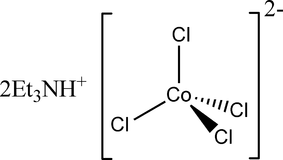
The complex salt
Answer
523.5k+ views
Hint: First just try to find the hybridization of the complex and then you can just calculate the electrons present. But keep in mind that if there is some charge left on the metal atom you have to satisfy that also. Now, you can easily solve this question.
Complete step by step answer:
First, we know that it is a tetrahedral complex so there is only one possibility of the hybridization of the molecule. That would be
In
You should know that here
Co has the atomic number 27, which means it has
In
x + 4(-1) = -2
x = +2
So, here copper is in +2 oxidation state. That means it loses 2 electrons from 4s orbital.
After losing 2 electrons it is left with only 7 electrons and those are located in 3d orbitals.

Therefore we can say that there are 7 d-electrons on the cobalt in complex salt
Note: The geometry of
Complete step by step answer:
First, we know that it is a tetrahedral complex so there is only one possibility of the hybridization of the molecule. That would be
In
You should know that here
Co has the atomic number 27, which means it has
In
x + 4(-1) = -2
x = +2
So, here copper is in +2 oxidation state. That means it loses 2 electrons from 4s orbital.
After losing 2 electrons it is left with only 7 electrons and those are located in 3d orbitals.

Therefore we can say that there are 7 d-electrons on the cobalt in complex salt
Note: The geometry of
Recently Updated Pages
Master Class 11 Computer Science: Engaging Questions & Answers for Success

Master Class 11 Accountancy: Engaging Questions & Answers for Success

Master Class 11 Physics: Engaging Questions & Answers for Success

Master Class 11 Business Studies: Engaging Questions & Answers for Success

Master Class 11 Maths: Engaging Questions & Answers for Success

Master Class 11 Chemistry: Engaging Questions & Answers for Success

Trending doubts
How much is 23 kg in pounds class 11 chemistry CBSE

What was the first capital of Magadha APatliputra BVaishali class 11 social science CBSE

How does Amoeba obtain its food a Endocytosis b Exocytosis class 11 biology ICSE

What is the molecular weight of NaOH class 11 chemistry CBSE

What is food class 11 biology CBSE

Write the differences between monocot plants and dicot class 11 biology CBSE




